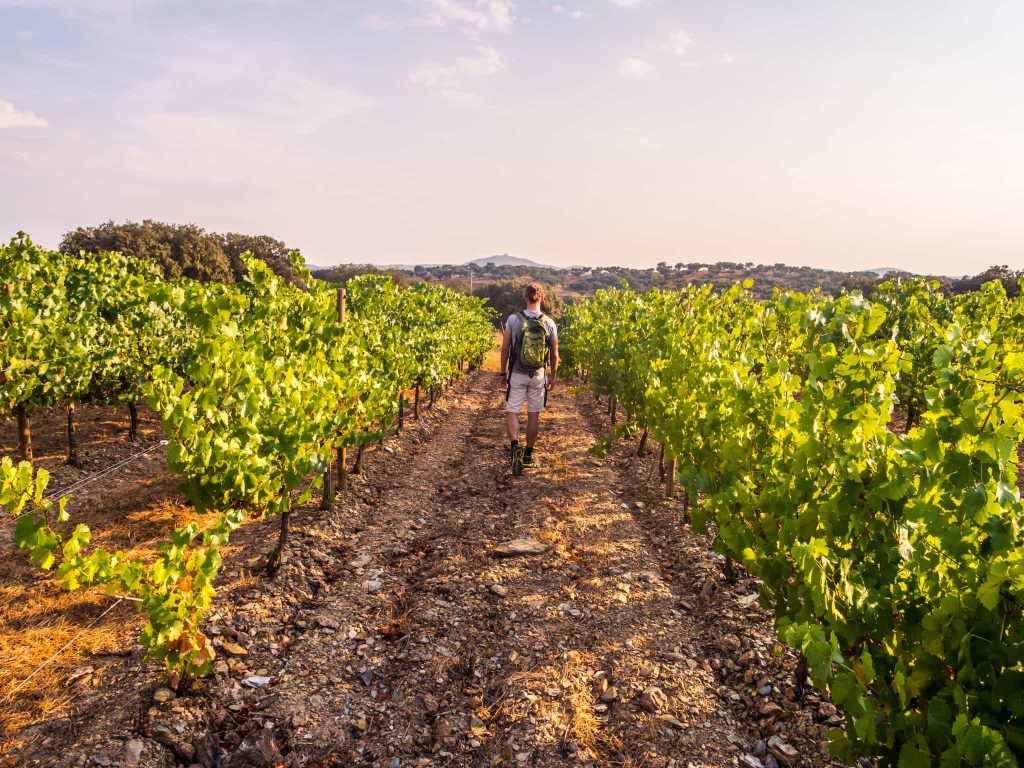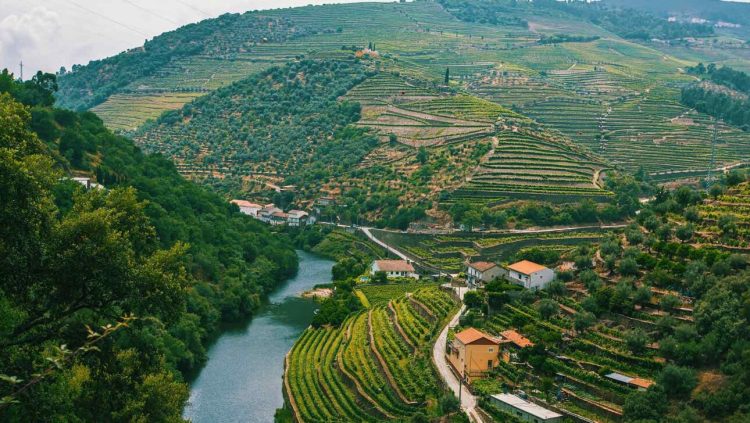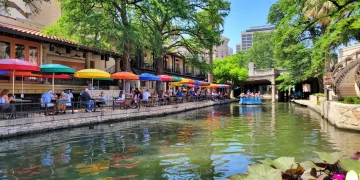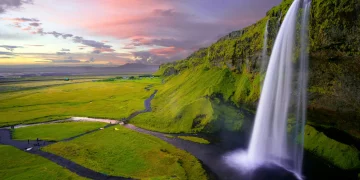The Quiet Revolution Beyond the Douro
In 2025, Alentejo is finally having its moment. Tucked between Lisbon and the Spanish border, this vast sun-drenched region is emerging as one of Europe’s most intriguing wine destinations—not with flashy marketing campaigns, but through whispers passed between wine lovers, food critics, and travelers seeking the uncrowded. While Douro Valley continues to attract tour buses and port enthusiasts, Alentejo offers something increasingly rare: space, silence, and a deeper connection between land and lifestyle. Travelers arrive expecting vineyards and are stunned to find cork forests, medieval towns, and chefs who forage before they ferment. It’s not the next Douro or Rioja—it’s the anti-Douro, and that’s precisely the appeal.
Where Cork Trees Meet Wineries
One of Alentejo’s defining features is its cork oak landscape. These ancient trees, with twisted trunks and sun-split bark, dot the vineyards in peaceful coexistence. Unlike other wine regions dominated by tight vine rows, Alentejo’s terrain feels like a wild garden. Wineries here—such as Herdade do Esporão, Herdade da Malhadinha Nova, and Adega Cartuxa—build their tasting rooms within this ecosystem, often using natural materials and design that blends with the land. What results is an immersive tasting experience: you’re not just sipping wine—you’re hearing birdsong, walking barefoot on stone patios, and inhaling eucalyptus.
The wines themselves have caught up with the scenery. Once dismissed as rustic reds for local taverns, Alentejo’s winemakers are now producing balanced, nuanced expressions using native grapes like Aragonez and Trincadeira. Amphora-aged whites, grown in schist and clay soils, are especially catching attention from sommeliers across Europe. Wine bars in London and Paris now feature “Alentejo Natural” sections on their lists. For those who travel for taste, this region is no longer optional.
The Rise of Open-Air Tastings and Slow-Food Pairings
Alentejo is not about rushed tastings or rigid schedules. It’s about long lunches on farm tables beneath cork trees, five-course slow-food dinners that begin at sunset and end by candlelight, and conversations with winemakers who also bake bread and raise black pigs. Many vineyards have adopted the slow tourism ethos, offering immersive day-long experiences instead of 30-minute pours.
At Herdade do Sobroso, tastings are held on a terrace overlooking the Guadiana River, followed by a local olive oil and cheese pairing. Malhadinha Nova offers horseback vineyard tours, blending enotourism with agritourism in a way that feels both grounded and luxurious. Some wineries now host cooking classes that focus on traditional Alentejan dishes like açorda (garlic-bread soup) and black pork secrets grilled over vine cuttings. This culinary depth is not an accessory—it’s central to the appeal.
Why Travelers Are Skipping Tuscany for Alentejo
In 2025, the European traveler is increasingly aware of overtourism. Tuscany, while timeless, has become emblematic of overcrowded wine roads and waitlisted farm stays. Alentejo offers the aesthetic and gastronomy without the crush. Instagram still matters, but now travelers want landscapes that feel authentic and undisturbed. Picture rolling golden fields, crumbling stone estates, and vineyards where you can walk for ten minutes and hear nothing but bees and breeze.
Alentejo’s towns—Évora, Monsaraz, Marvão—deliver old-world charm without curated artifice. Boutique hotels like São Lourenço do Barrocal or Torre de Palma Wine Hotel are rewriting what wine-lifestyle hospitality looks like, combining contemporary design with respect for the land. Travelers who’ve done Tuscany, Provence, and Napa are calling Alentejo their most surprising discovery—one that’s not quite a secret anymore, but still feels like one.

Eco-Conscious Travel Meets Regenerative Viticulture
Alentejo’s rise also mirrors a deeper shift in how wine regions are evaluated. Climate change has challenged southern Europe’s vineyards, but Alentejo’s winemakers have embraced adaptation. Many estates are moving toward regenerative agriculture, employing dry farming, cover crops, and biodiversity corridors. Esporão now uses organic practices across all its vineyards and has implemented energy-efficient cellars with solar panels and rainwater systems.
This ecological awareness resonates with travelers who want their wine to have a backstory beyond terroir. Guided tours now include soil health discussions, and tasting menus often note the carbon footprint of pairings. Alentejo is positioning itself not just as a place of taste, but of conscience. That blend—sensual and sustainable—is increasingly what today’s wine traveler is after.
The Role of Digital Nomads and Slow Living Seekers
An unexpected player in Alentejo’s transformation is the remote worker. Post-pandemic lifestyle shifts have turned digital nomads into a mobile class of slow-living seekers. While Lisbon and Porto remain hubs, many are now buying homes or booking month-long stays in Alentejo, drawn by nature, local markets, and the chance to live simply yet richly.
They’re writing blog posts about cafés in Estremoz where time slows down, filming drone videos over sunrise vineyards, and sharing photos of homemade vinho verde on Substack newsletters. Their presence is helping Alentejo transcend its reputation as a rural outpost and rebrand as a luxury-meets-livability zone. Locals are responding in kind—markets are thriving, new bistros are opening, and co-working spaces are popping up in old stone barns.
What to Drink and Where
For those mapping their 2025 wine journey through Alentejo, a few bottles are commanding attention. The amphora-aged whites from Herdade do Rocim are a revelation—textured, slightly salty, and full of character. The reserve reds from Quinta do Mouro balance power and finesse, while Adega Mayor’s minimalist design and biodynamic practices set a modern tone.
In terms of regions, head to Reguengos de Monsaraz for bold reds, Vidigueira for elegant whites, and Borba for rustic heritage producers. The Alentejo Wine Route, now fully digitized with interactive GPS maps and QR codes at vineyards, allows for curated journeys based on traveler interests—eco-tourism, food-forward pairings, or rare varietals.
Traveler Testimonials
Those who’ve been are quick to share. “We expected rustic charm,” said Helena, a Danish travel photographer. “What we found was elegance. The wines were structured, the food unforgettable, and the landscape cinematic.” James, an American chef visiting for research, noted, “This is what Tuscany used to feel like—before it became a brand.”
And that may be Alentejo’s greatest asset. It’s still a place of becoming. Of rediscovery. Of tradition rediscovered as trend. Of food that tells stories and wine that whispers instead of shouts. It doesn’t have the fame of Rioja, the flash of Napa, or the postcard predictability of Provence. But it has soul—and in 2025, that’s what matters.





















